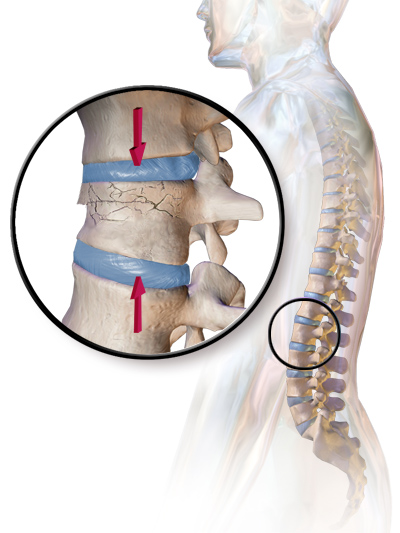Vertebral Compression Fracture
A compression fracture is characterised by the collapse of a vertebra, often due to trauma or weakening of the vertebral body. The weakening is commonly seen in conditions like osteoporosis, osteogenesis imperfecta, and lytic lesions from metastatic or primary tumours, as well as infections.
In otherwise healthy individuals, such fractures can occur due to extreme vertical shocks, such as ejection from an ejection seat.
Compression fractures typically present as wedge deformities on lateral x-ray films, with a greater loss of height anteriorly than posteriorly, while the pedicles remain intact in the anteroposterior view.

Introduction
Signs and Symptoms
Acute vertebral compression fractures often present with severe back pain. In contrast, fractures that develop gradually, such as those associated with osteoporosis, may initially be asymptomatic. Over time, these fractures can lead to chronic back pain and a noticeable loss of height.
Diagnosis
Compression fractures are primarily diagnosed through spinal radiographs, where a wedge-shaped vertebra or loss of vertebral height can be observed. If osteoporosis is suspected, bone density measurements are performed. In cases where a tumour is suspected or severe trauma is involved, further imaging with CT or MRI scans may be necessary.



Treatment
Conservative Treatment
Conservative management of vertebral compression fractures includes the use of back braces to support the spine during healing. The type of brace used depends on the severity and stability of the injury. A Jewett brace may be used for relatively stable and mild injuries, whereas a thoracic lumbar sacral orthosis (TLSO) is preferred for more severe cases. Pain management is essential and can involve opioids or non-steroidal anti-inflammatory drugs (NSAIDs). Calcitonin may be beneficial for patients with osteoporosis to help manage pain and support bone health.
Surgical Treatment
Surgical options for treating vertebral compression fractures include kyphoplasty and vertebroplasty. These minimally invasive procedures involve injecting cement into the fractured vertebra to stabilise it and relieve pain. However, the effectiveness of these procedures is debated, and the data supporting their use is mixed.
A potential complication of vertebral compression fractures is avascular necrosis of the vertebral body, known as Kümmel's disease. This condition may be identified by the intravertebral vacuum cleft sign on imaging.

Self-assessment MCQs (single best answer)
What type of deformity is typically seen in vertebral compression fractures on lateral x-ray films?
Which of the following is a common cause of vertebral compression fractures?
What imaging modality is primarily used to diagnose vertebral compression fractures?
What is a potential complication of vertebral compression fractures that involves avascular necrosis of the vertebral body?
In the conservative treatment of vertebral compression fractures, what type of brace is typically used for relatively stable and mild injuries?
Which of the following medications may be used to manage pain and support bone health in patients with osteoporosis and vertebral compression fractures?
What is the term for the intravertebral vacuum cleft sign seen in some vertebral compression fractures?
Which of the following conditions is NOT commonly associated with vertebral compression fractures?
What minimally invasive surgical procedure for vertebral compression fractures involves injecting cement into the fractured vertebra?
In cases of severe trauma, which imaging modality may be used in addition to spinal radiographs to diagnose vertebral compression fractures?
Dentaljuce
Dentaljuce provides Enhanced Continuing Professional Development (CPD) with GDC-approved Certificates for dental professionals worldwide.
Founded in 2009 by the award-winning Masters team from the School of Dentistry at the University of Birmingham, Dentaljuce has established itself as the leading platform for online CPD.
With over 100 high-quality online courses available for a single annual membership fee, Dentaljuce offers comprehensive e-learning designed for busy dental professionals.
The courses cover a complete range of topics, from clinical skills to patient communication, and are suitable for dentists, nurses, hygienists, therapists, students, and practice managers.
Dentaljuce features Dr. Aiden, a dentally trained AI-powered personal tutor available 24/7 to assist with queries and provide guidance through complex topics, enhancing the learning experience.
Check out our range of courses, or sign up now!


